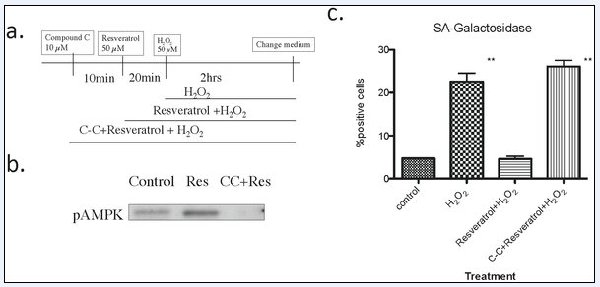ResveratrolConsumer
avert online
consumer fraud
ResveratrolQuiz
test your knowledge
New E-Book
How the world got lost on
the road to an anti-aging pill
Subscribe to our newsletter to receive email notifications when new articles are posted.
April 21, 2012: by ResveratrolNews
Abridged summary: researchers have found that even very low dose intermittent exposure (twice in a 5-day period) to hydrogen peroxide, which is generated by exposure to unfiltered sunlight, induces aging of cells in the outer layer of the skin (epidermis) but that the red wine molecule resveratrol completely blocks senescence of these cells which may be chronically exposed to solar ultraviolet radiation.
Researchers in the experiment presented below show that hydrogen peroxide (H2O2-)induced premature senescence in primary human keratinocytes (cells found in the outer layer of the skin/epidermis) can be prevented by AMPK activation. (AMPK is a master metabolic activating enzyme.)
Cells that are senescent are no longer capable of dividing and skin renewal. Thus, researchers found that: (1) a low dose of hydrogen peroxide (H2O2 50 µM) activates two primary genes (p53 and secondarily p21)in these cells and subsequently increased SA-Galactosidase (SA-Ga1) activity, a marker of cellular senescence, and that (2) prior activation of AMPK by resveratrol prevented these H2O2-induced changes
PLoS One. 2012;7(4):e35092. Epub 2012 Apr 13.
Ido Y, Duranton A, Lan F, Cacicedo JM, Chen TC, Breton L, Ruderman NB.
Section of Endocrinology and Diabetes Research Unit, Department of Medicine, Boston University School of Medicine, Boston, Massachusetts, United States of America.
We investigated the effects of AMPK on H(2)O(2)-induced premature senescence in primary human keratinocytes. Incubation with 50 µM H(2)O(2) for 2 h resulted in premature senescence with characteristic increases in senescence-associated ß-galactosidase (SA-gal) staining 3 days later and no changes in AMPK or p38 MAPK activity. The increase in SA-gal staining was preceded by increases in both p53 phosphorylation (S15) (1 h) and transactivation (6 h) and the abundance of the cyclin inhibitor p21(CIP1) (16 h). Incubation with AICAR or resveratrol, both of which activated AMPK, prevented the H(2)O(2)-induced increases in both SA-Gal staining and p21 abundance. In addition, AICAR diminished the increase in p53 transactivation. The decreases in SA-Gal expression induced by resveratrol and AICAR were prevented by the pharmacological AMPK inhibitor Compound C, expression of a DN-AMPK or AMPK knock-down with shRNA. Likewise, both knockdown of AMPK and expression of DN-AMPK were sufficient to induce senescence, even in the absence of exogenous H(2)O(2). As reported by others, we found that AMPK activation by itself increased p53 phosphorylation at S15 in embryonic fibroblasts (MEF), whereas under the same conditions it decreased p53 phosphorylation in the keratinocytes, human aortic endothelial cells, and human HT1080 fibrosarcoma cells. In conclusion, the results indicate that H(2)O(2) at low concentrations causes premature senescence in human keratinocytes by activating p53-p21(CIP1) signaling and that these effects can be prevented by acute AMPK activation and enhanced by AMPK downregulation. They also suggest that this action of AMPK may be cell or context-specific.
PMID:22514710

Full text of paper: http://www.plosone.org/article/info%3Adoi%2F10.1371%2Fjournal.pone.0035092
Posted in Resveratrol
Add comments »